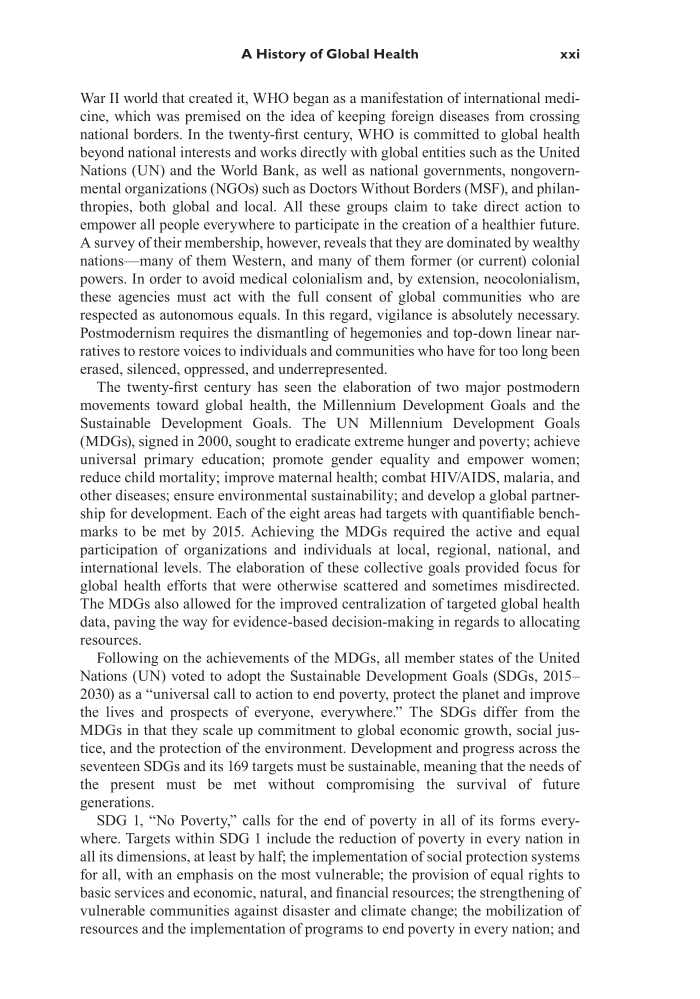A History of Global Health xxi War II world that created it, WHO began as a manifestation of international medi- cine, which was premised on the idea of keeping foreign diseases from crossing national borders. In the twenty-first century, WHO is committed to global health beyond national interests and works directly with global entities such as the United Nations (UN) and the World Bank, as well as national governments, nongovern- mental organizations (NGOs) such as Doctors Without Borders (MSF), and philan- thropies, both global and local. All these groups claim to take direct action to empower all people everywhere to participate in the creation of a healthier future. A survey of their membership, however, reveals that they are dominated by wealthy nations—many of them Western, and many of them former (or current) colonial powers. In order to avoid medical colonialism and, by extension, neocolonialism, these agencies must act with the full consent of global communities who are respected as autonomous equals. In this regard, vigilance is absolutely necessary. Postmodernism requires the dismantling of hegemonies and top-down linear nar- ratives to restore voices to individuals and communities who have for too long been erased, silenced, oppressed, and underrepresented. The twenty-first century has seen the elaboration of two major postmodern movements toward global health, the Millennium Development Goals and the Sustainable Development Goals. The UN Millennium Development Goals (MDGs), signed in 2000, sought to eradicate extreme hunger and poverty achieve universal primary education promote gender equality and empower women reduce child mortality improve maternal health combat HIV/AIDS, malaria, and other diseases ensure environmental sustainability and develop a global partner- ship for development. Each of the eight areas had targets with quantifiable bench- marks to be met by 2015. Achieving the MDGs required the active and equal participation of organizations and individuals at local, regional, national, and international levels. The elaboration of these collective goals provided focus for global health efforts that were otherwise scattered and sometimes misdirected. The MDGs also allowed for the improved centralization of targeted global health data, paving the way for evidence-based decision-making in regards to allocating resources. Following on the achievements of the MDGs, all member states of the United Nations (UN) voted to adopt the Sustainable Development Goals (SDGs, 2015– 2030) as a “universal call to action to end poverty, protect the planet and improve the lives and prospects of everyone, everywhere.” The SDGs differ from the MDGs in that they scale up commitment to global economic growth, social jus- tice, and the protection of the environment. Development and progress across the seventeen SDGs and its 169 targets must be sustainable, meaning that the needs of the present must be met without compromising the survival of future generations. SDG 1, “No Poverty,” calls for the end of poverty in all of its forms every- where. Targets within SDG 1 include the reduction of poverty in every nation in all its dimensions, at least by half the implementation of social protection systems for all, with an emphasis on the most vulnerable the provision of equal rights to basic services and economic, natural, and financial resources the strengthening of vulnerable communities against disaster and climate change the mobilization of resources and the implementation of programs to end poverty in every nation and
Document Details My Account Print multiple pages
Print
You have printed 0 times in the last 24 hours.
Your print count will reset on at .
You may print 0 more time(s) before then.
You may print a maximum of 0 pages at a time.















































































































































































































































































































































































































































































































































































































































































































































































































































































































































































































































































































